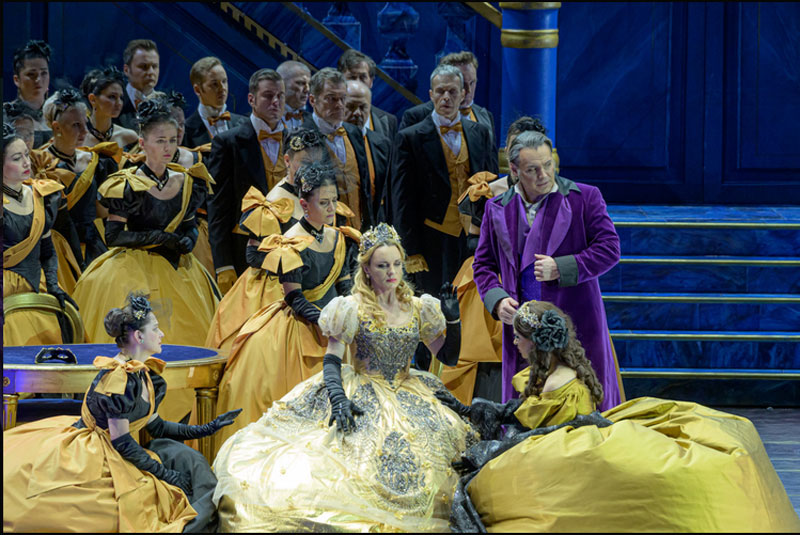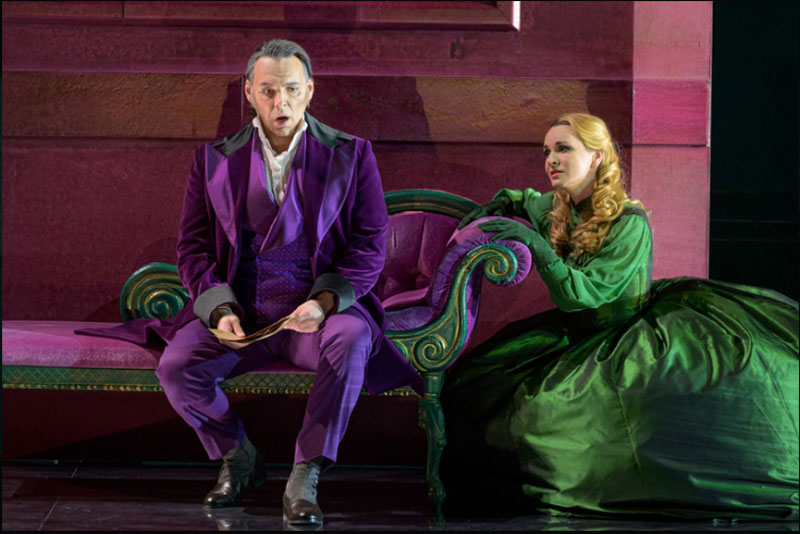All this can be learned by reading the house programme published for the new production, a small volume on which we would like some Western opera houses to model themselves : instead of abstruse speculations on the meaning of the work, it provides information on the various productions of the work (eight before the one premiered in 2021, including Jonathan Miller's production, borrowed from the English National Opera in 2005) and on the many performers of the three main roles : we learn, via colour photographs, that Asmik Grigorian, whose father is Armenian but whose mother is Lithuanian, was a superb Violetta in two different productions, and that Alfredo was sung by a student of the Vilnius Conservatory named Sergejus Larinas (better known as Sergej Larin). All these images also allow reflect the diversity of styles adopted over the course of a century of history, from the 'modern costume' used as early as 1920 (Violetta as flapper), through the crinolines that dominated most productions, to the return to contemporary outfits desired by director Chen Shi-Zheng in 2009.
Presumably due to the disruption caused by the pandemic, the Lithuanian National Opera was unable to offer a 'Centenary Traviata' on 31 December 2020, so the new production premiered the following November, contrary to tradition. For the second time this season, after Der Rosenkavalier entrusted to Damiano Michieletto in September, Vilnius called on an Italian director, and in both cases the result is a production that turns its back on realism to show what is going on in the head of the main character, sometimes through the use of disconcerting symbolism. It is true that Piave's libretto after Dumas fils does not lend itself as naturally as Hoffmannsthal's text to this kind of exploration, but Fabio Ceresa nonetheless manages to impose a personal vision on the work.

This new production relies first of all on the spectacular : monumental sets in striking colours, emerald green in Violetta, fuchsia pink in the countryside, royal blue in Flora, with grand staircases and chandeliers, Met subscribers would be in for a treat. Costumes refer to the mid-19th century, with crinolines for all the ladies and top hats for the gentlemen, the chorus being treated here not as a collection of individuals, but as a block whose members all wear the same outfit (with different shades of pink in the first act, yellow in the second). In other words, from a distance, one might think that this is a fairly traditional Traviata. Except that, from the opening, Fabio Ceresa finds a way to make the heroine's illness immediately visible : Violetta's left hand is blackened, as if necrotic, forcing her to wear gloves in society.

This black hand will be at the centre of the stage play on several occasions, from the first duet with Alfredo, then during the party at Flora's house, where a pantomime shows a double of Violetta who looks like Death itself. And in the last act, as the Carnival procession of the Fattened Ox passes in the street, three minotaurs with long clawed fingers come and circle the dying woman. But Violetta does not die, or at least she is allowed a kind of Liebestod, as she escapes into the space that opens up at the back of the stage and remains standing when the curtain falls. This backstage area (which Michieletto exploited extensively, even doubling it up in his Rosenkavalier) is used here to illustrate Germont's speech in Act II, with masked extras showing Alfredo's sister being abandoned by her fiancé, or, during 'Di Provenza il mare, il suol', with a landscape of lavender fields where the characters can roam (and where Violetta will eventually wander).
For the many performances planned, the Vilnius Opera has planned a double or even triple cast for most of the roles, drawing on the solid resources of its company. The characteristic figure of Rafailas Karpis, who was an incredible Valzacchi a few months ago, can here be seen as Gastone, while Monika Pleškitė, Sophie in September, is now Annina. As for the three main roles, they are Lithuanian artists with international careers.

Kostas Smoriginas was applauded vigorously at the end of the performance, but he seemed to offer the minimum service as Germont. The voice is powerful and well timed, but the diction of the Italian is very loose and the interpreter does not go in for subtleties. Other baritones have accustomed us to much more delicacy, even in such an admittedly detestable character, notably when they take care to vary each the emission of each repeated phrase of "Di Provenza il mar, il suol".
Katerina Tretyakova is a sculptural Violetta, who magnificently sports the dresses designed by Giuseppe Palella. Vocally, one admires her punchy projection, but the first act does not seem ideally written for the soprano. The vocalizations of "Follie, follie" are not delivered with the precision one expects, which is a pity, and the singer is much more at ease in the other two acts, where she can show an expressiveness capable of touching the audience, either through her beautiful pianissimi in the duet with Germont, or through the parlando which she does not hesitate to resort to for some of her final lines. As for Edgaras Montvidas, well known to French audiences who have applauded him on several occasions, notably as Werther in Nancy, his Alfredo – a role he had already sung in Vilnius earlier in his career – offers an ideal blend of youthful love and virile valour, without being stingy with nuances, for a complete portrait of his character.
In the pit, Ričardas Šumila adopts brisk tempos, giving his direction an undeniable theatrical effectiveness. Sure of being able to count on the vocal power of the protagonists, he deliberately unleashes his orchestra, especially in "Amami, Alfredo", where the percussion is particularly present. The well-stocked choir also does credit to the Lithuanian National Opera, whose centenary is thus celebrated as it should be, even if a little behind schedule
